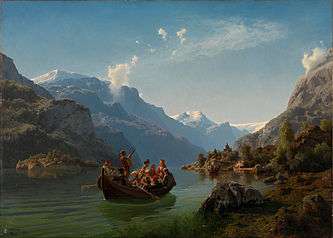Bridal Procession on the Hardangerfjord
Bridal Procession on the Hardanger (Norwegian: Brudeferd i Hardanger) is an 1848 painting by Hans Gude and Adolph Tidemand.[1] It is one of the best known Norwegian paintings.[2][3] Gude painted the landscapes and Tidemand the bridal party.[4][5] The painting is 93 x 130 cm, and is in the National Gallery in Oslo.[5][6] It is considered to be an excellent example of romantic nationalism in Norway.[7][8][9]
| Bridal Procession on the Hardangerfjord | |
|---|---|
| Norwegian: Brudeferd i Hardanger | |
 | |
| Artist | Hans Gude and Adolph Tidemand |
| Year | 1848 |
| Dimensions | 93 cm × 130 cm (37 in × 51 in) |
| Location | National Gallery, Oslo |
In the painting, a bridal procession crosses a fjord in boats, after the wedding. The groom, tipping his hat, and the bride, in her bridal crown, can be seen in the first boat. The boat crew are dressed in typical Bunad costumes. In the distance, other boats with guests of the wedding can be seen.[10][11] The scene, Gude later wrote, was not as viewed from a particular location, but was deliberately composed from his overall observations.[12]
The painting was first presented in a tableau vivant at the Christiania Theater in 1849.[13] The soirée, in March 1849, included a theatrical group dressed in traditional costumes aboard a boat who performed a song by Andreas Munch with music by Halfdan Kjerulf, with the painting itself serving as scenery.[10][14]
Further reading
| Norwegian Wikisource has original text related to this article:
Brudefærden Lyrics (in Norwegian) of Munch's song |
- Kirkholt, Tore (30 May 2014). "'Brudeferd i Hardanger' – Originalbildet som fikk nytt liv som postmoderne repetisjon" [Bridal Procession in Hardanger" – The original painting that was revived as postmodern repetition]. Kunst og Kultur (in Norwegian). 97 (02): 66–76. ISSN 1504-3029. Retrieved 24 August 2018.
References
- Gérard Denizeau (2004). Vocabulaire des arts visuels du XIXe siècle. Minerve. ISBN 978-2-86931-108-4.
- Arne Neset (2009). Arcadian Waters and Wanton Seas: The Iconology of Waterscapes in Nineteenth-century Transatlantic Culture. Peter Lang. pp. 122–. ISBN 978-1-4331-0297-4.
- Anna C. Rue (2009). "In The Party Circle": Norwegian-Americans and their fiddle. University of Wisconsin—Madison.
- Margaret Hayford O'Leary (2010). Culture and Customs of Norway. ABC-CLIO. pp. 171–. ISBN 978-0-313-36248-4.
- "Hans Gude, Adolph Tidemand, Bridal Procession on the Hardangerfjord – Nasjonalmuseet – Collection".
- "Bridal Procession on the Hardangerfjord – Hans Gude – Google Arts & Culture".
- Tuchtenhagen, R. (2011). Kleine Geschichte Norwegens. Beck'sche Reihe (in German). C.H.Beck. p. 118. ISBN 978-3-406-61563-4. Retrieved 24 August 2018.
Werke wie Højfjæld (Hochfjell, 1857) und das gemeinsam mit Tidemand angefertigte Brudeferd i Hardanger (s. o.) sowie Brenninger (Brände, 1862) wurden zum Inbegriff der norwegischen nationalen Topographie. Nicht nur in der ...
- Toril Moi (14 February 2008). Henrik Ibsen and the Birth of Modernism: Art, Theater, Philosophy. OUP Oxford. pp. 246–. ISBN 978-0-19-150264-4.
- Daniel M. Grimley (2006). Grieg: Music, Landscape and Norwegian Identity. Boydell Press. pp. 67–. ISBN 978-1-84383-210-2.
- Ann Schmiesing (2006). Norway's Christiania Theatre, 1827–1867: From Danish Showhouse to National Stage. Fairleigh Dickinson Univ Press. pp. 98–. ISBN 978-0-8386-4107-1.
- Gesammelte Aufsätze zur Kulturgeschichte Spaniens. Aschendorff. 1916.
- Skurtveit, Nina (13 October 2008). "Brudeferden i Hardanger". Kultur og underholdning (in Norwegian). Norsk rikskringkasting. Retrieved 24 August 2018.
- Mette Hjort; Ursula Lindqvist (24 March 2016). A Companion to Nordic Cinema. John Wiley & Sons. pp. 282–. ISBN 978-1-118-47527-0.
- Ann Falahat; Marit Ingeborg Lange; Nasjonalgalleriet (Norway) (2003). Hans Fredrik Gude på papir. Nasjonalgalleriet. ISBN 978-82-90744-87-3.